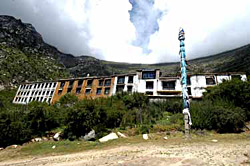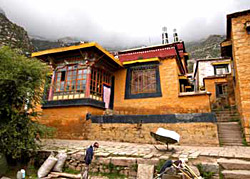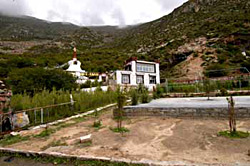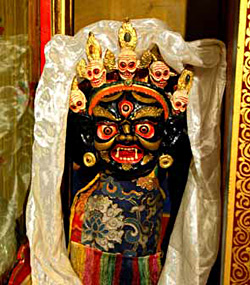Location and Layout

The front façade of Garu Nunnery (Garu GönpaGa ru dgon pa).
Garu Nunnery (Garu GönpaGa ru dgon pa), one of the oldest nunneries in the LhasaLha sa area, is located northwest of SeraSe ra at the western end of the NyangdrenNyang bran Valley. It takes about two hours to walk to GaruGa ru from SeraSe ra. The GaruGa ruGorge is relatively remote and quite beautiful. The area below the nunnery is pasture land, and is used by the nuns to graze their one hundred-plus head of yaks.2 These pastures gradually slope upward (north) to the hermitage (ritröri khrod), which is located at the base of a very rocky portion of the northern mountains next to a stream. The nunnery faces south towards LhasaLha sa, and it affords one of the most beautiful long-distance views of the city and of the PotalaPo ta la.
The word garuga ru derives from gargar, which means “dance.” The famed Indian master Pa Dampa SanggyéPha dam pa sangs rgyas (b. eleventh century) saw ḍākinīs dancing at the spot where the monastery now stands, and gave it this name.
As is the case with most religious institutions in the LhasaLha sa Valley, the natural landscape surrounding the site is imbued with religious significance. The resident nuns associate several of the mountains near the nunnery with different deities:
- The peak northwest of the hermitage is called the Palace of Cakrasaṃvara (Demchokgi PodrangBde mchog gi pho brang)
- Three rock outcroppings just north of the nunnery are called the Three Protectors (Riksum GönpoRigs gsum mgon po)
- A flat cliff-face on a mountain northwest of the site is called the Mirror of Vajrabhairava (Jikjekyi Melong’Jigs byed kyi me long)
- Another peak northeast of the nunnery is identified as the Soul-Mountain of Mañjuśrī (Jampelyangkyi Lari’Jam dpal dbyangs kyi bla ri)
A short history of the nunnery identifies the various sites around the nunnery more extensively (though somewhat differently) than the oral account:
The mountain in back [of the nunnery] is called “the Soul-Mountain of Tārā” (Taré LariTā rā’i bla ri). Near that a [rock outcropping] that has the shape of a right-turning white conch shell is clearly visible. The western mountain is called “the Soul-Mountain of Mañjuśrī” (Jampelyangkyi Lari’Jam dpal dbyangs kyi bla ri), and it has splendid pastures and rock-faces. At the foot of that mountain there is a “storehouse of sindhura”3 that emits sindhura on some holy days. On some occasions the sound made by a white conch4 can also be heard coming from the side of that mountain. To the right of that mountain is a rock-face that is considered to be a self-arisen image of Vajrabhairava because it resembles the body of the deity. To the left is an imposing mountain whose combination of meadows and rock-faces are considered to form a self-arisen image of Guhyasamāja. To the northeast is “the Soul-Mountain of the Arhats” (Neten LariGnas brtan bla ri) that has amazingly designed rock formations. To the east is a mountain known either as “the Parasol” (Dukpé LariGdugs pa’i bla ri) or as “Mañjuśrī Peak” (Jampel Lari’Jam dpal bla ri).5
The entire area around the nunnery is said to be hospitable to a variety of wildlife. The various animals that live here, it is said, are unafraid of the human inhabitants of the site, occasionally even entering into the nuns’ rooms. The area is also filled with a variety of wild flowers and herbs. These are collected as the ingredients used in Tibetan medicine, and it is not uncommon for LhasaLha sa physicians to bring their students to the area around GaruGa ru to teach them the art of identifying and collecting medicinal plants.
Garu Nunnery is one very large compound enclosed by a perimeter wall. This larger compound contains within it several sub-compounds or complexes of buildings. At the very center of the nunnery is the largest and most important complex that contains the main temple, the kitchen, and several small chapels – a Scripture Temple (Kangyur lhakhangBka’ ’gyur lha khang), a butter-lamp offering house (chömé khangchos me khang), and a building where the nuns take turns keeping watch at night. These various structures, together with two wings of nuns’ rooms, form the central courtyard of the hermitage. These buildings also appear to be the oldest in the hermitage, and the nuns themselves state that most of the additional wings of living quarters located at the four corners of the larger compound were added later as the nunnery grew.

The front of the main temple.
To the north of – that is, just behind – the main temple there is a very long wing of nuns’ rooms. There are also different complexes of nuns’ rooms built around central courtyards at the northeast, southeast, and southwest corners of the monastery. The buildings at the northwest corner of the monastery, the nuns say, were used for visiting dignitaries; some of these may have also served as residences of senior nuns.
There are other important sites and minor structures outside of the walls of the main compound:
- East. Along the eastern edge of the nunnery there is a small park that contains a public performance space. Lay people bring picnics and spend the day here when they come for worship (chönjelmchod mjal). On special occasions the raised concrete dais in the center of the park is used as a stage for folk opera or other performances. At the northern edge of that park are a stūpa and a guest house. In 2004, the latter had just recently been built.
- West. A stream runs along the western edge of the nunnery. The sound of the rushing water is said to resemble the sound of the “Three-Oṁ Dhāraṇī of the Queen Dorjé TsünmoRdo rje btsun mo.” Near the place along the stream where the nuns come to collect the water, one can clearly see a self-arisen image of the letter “ba” on the side of a boulder. This is the seed syllable of Dorjé TsünmoRdo rje btsun mo.6 Two mani wheels (mani khorloma ṇi ’khor lo) have been built over the stream; they are made to turn by the power of the rushing water.
- South. Several small shrines are found just outside the southern perimeter wall of the nunnery. One of these, called the Damala NyakDā ma la nyag, marks the spot where Pa Dampa SanggyéPha dam pa sangs rgyas heard the word “damadā ma.” Another is said to mark the spot where he received an offering of milk from a magical white cow that was a Buddha-emanation, and near to this is the boulder with the self-arisen letters “a ma” into which the cow dissolved. (See below for more detailed accounts of the narratives related to these various sites.)
- North. At the northern edge of the nunnery there is relatively little – only one small shrine to a Tenmabstan ma deity, and a few boulders with self-arisen images.

The park and performance area in the foreground, with the guest house and stūpa behind it.
About one kilometer south of the monastery, just off the main road, is a small shrine that contains a self-arisen image of one of the eyes of Cakrasaṃvara (DemchokBde mchog).7
Almost all of the statuary and art inside the temple is new, but GaruGa ru is unusual insofar as we have some idea of the images that existed inside the main temple prior to 1959. That main temple was a “twelve pillar” temple,8 and the central image on its main altar was a Thousand-Armed Avalokiteśvara, one-story tall. To the left was a smaller Thousand-Armed Avalokiteśvara figure and to the right was a statue of Pa Dampa SanggyéPha dam pa sangs rgyas when he was an eight-year-old child.9 On his lap was kept a manuscript text of a prayer (about ten folios in length) said to have been written by Pa Dampa SanggyéPha dam pa sangs rgyas in his own hand.10 This statue and Pa DampaPha dam pa’s own manuscript text were together considered the “main inner image(s)” (nangten tsowonang rten gtso bo) of the nunnery. On the interior walls of the temple there hung a series of fifteen extremely well-executed tangkathang kas of the “Eighty Deeds of Tsongkhapa” (Tsongkha GyepchuTsong kha brgyad bcu), donated to the monastery by “a Mongolian queen.”11 Apparently the Thirteenth Dalai Lama (Dalai Lama Kutreng ChuksumpaDa lai bla ma sku phreng bcu gsum pa) asked for these to be brought to the Norbu LingkhaNor bu gling kha, the Dalai LamaDa lai bla mas’ summer palace, and told the nuns to ask for anything they wanted in return. The elder nuns, however, declined, refusing to part with the tangkathang kas, and so the paintings remained in the nunnery until 1959. Their whereabouts today are unknown.
In addition, the following statues were to be found in the temple:
- A life-size figure of Vajrayoginī (Dorjé NeljormaRdo rje rnal ’byor ma)
- A series of statues of the various incarnations of the Dalai LamaDa lai bla mas12
- Four metal-alloy statues of the Drakri incarnations (Drakri TrülkuBrag ri sprul sku)13 that were said to be simulacra (draku’dra sku) – that is, actually resembling these various figures
- Two sets of statues of the Eight Medicine Buddhas (Menla Deshek GyéSman bla bde gshegs brgyad), one made of clay (and life-size), another of metal (and smaller)
- A life-size statue of Pabongkha RinpochéPha bong kha rin po che
In addition to these various statues, as representatives of the Buddha’s speech there were:
- A volume of the Eight Thousand Line Perfection of Wisdom Sūtra (Pakpa Sherapkyi Paröltu Chinpa Gyetongpé Do’Phags pa shes rab kyi pha rol tu phyin pa brgyad stong pa’i mdo, Āryāṣṭasāhasrikāprajñāpāramitā Sūtra) written in gold
- A complete set of the KangyurBka’ ’gyur
- Complete sets of the short, middling, and extensive Perfection of Wisdom Sūtras (Sherapkyi Paröltu Chinpé DoShes rab kyi pha rol tu phyin pa’i mdo, Prajñāpāramitā Sūtra).
As representations of the Buddha’s mind, there were replicas of the “eight shāli stūpas of India.”
In the altar of Drakri RinpochéBrag ri rin po che’s rooms, located on top of the main temple, there used to be very fine statues of the Sixteen Arhats (Neten ChudrukGnas brtan bcu drug), the HashangHwa shang, and the four direction protectors.
In the protector deity chapel (gönkhangmgon khang) there were statues of:
- Six-Armed Mahākāla (Gönpo ChakdrukMgon po phyag drug)
- Hayagrīva in his “Secret Accomplishment” form (Tamdrin SangdrupRta mgrin gsang sgrub)14
- Dharmarāja (Damchen ChögyelDam chen chos rgyal)
- Penden LhamoDpal ldan lha mo
- Vaiśravaṇa (NamséRnam sras)
- mgon po a gho[ra] . It appears that only the head of this deity survives. In 2004, the body of the image had yet to be created.
- Gyelchen Karma TrinléRgyal chen karma ’phrin las

The head or face-mask of mgon po a gho[ra] in the protector deity chapel.
On the topmost floor there was a Tārā chapel (Drölma LhakhangSgrol ma lha khang) with statues of the twenty-one Tārās. There was also a statue of Maitreya (JampaByams pa) in this chapel.
In addition to these various images, there were also two self-arisen footprints (zhapjézhabs rjes) – one made by Pa Dampa SanggyéPha dam pa sangs rgyas, and the other by the horse of the second Drakri incarnation Gyatso Chönjor (Drakri Kutreng Nyipa Gyatso ChönjorBrag ri sku phreng gnyis pa rgya mtsho chos ’byor).15 With one or two exceptions, none of the various images and religious artifacts mentioned above survived the Cultural Revolution, though many have been replaced by replicas.
Hermitages Home
Table of Contents
- Location and Layout
- History
- Glossary
- Notes
- Specify View:
- Specify Format:
 |  |  |